Home automation systems offer renters a unique opportunity to enhance their living spaces with features that prioritize convenience, security, and energy efficiency. Designed for easy installation and flexibility, these systems allow renters to enjoy modern technology without making permanent changes to their homes. With advanced monitoring options and remote management capabilities, renters can significantly improve their security and overall living experience.
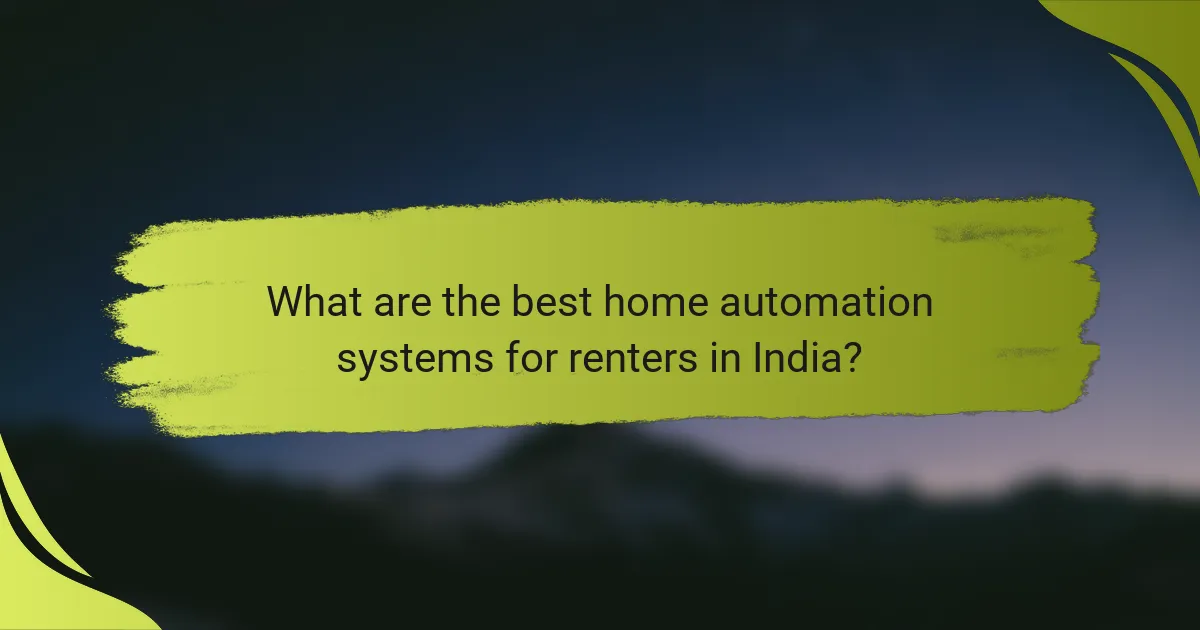
What are the best home automation systems for renters in India?
The best home automation systems for renters in India focus on ease of installation, affordability, and flexibility. These systems allow renters to enhance their living spaces without permanent modifications, making them ideal for temporary residences.
Google Nest Hub
The Google Nest Hub serves as a central control panel for various smart devices, allowing renters to manage their home automation seamlessly. With its user-friendly touchscreen interface, you can easily access and control compatible devices like lights, cameras, and thermostats.
Consider the Nest Hub’s voice control capabilities, which integrate with Google Assistant. This feature enables hands-free operation, making it convenient for daily tasks. Additionally, its compact design fits well in any room, enhancing both functionality and aesthetics.
Amazon Echo Dot
The Amazon Echo Dot is a versatile smart speaker that provides voice control for a range of smart home devices. Its affordability and compact size make it a popular choice among renters looking to automate their homes without significant investment.
With Alexa built-in, you can control lights, plugs, and more through simple voice commands. The Echo Dot also allows for routine scheduling, enabling you to automate tasks like turning off lights at night or adjusting the thermostat during the day.
Philips Hue Smart Lighting
Philips Hue Smart Lighting offers renters the ability to create customizable lighting solutions without extensive installation. These smart bulbs can be easily replaced in existing fixtures, making them a non-invasive option for home automation.
With the Philips Hue app, you can control the brightness and color of your lights, set schedules, and even sync them with music or movies for an immersive experience. This flexibility allows you to personalize your living space while adhering to rental agreements.
TP-Link Kasa Smart Plugs
TP-Link Kasa Smart Plugs are an excellent choice for renters looking to automate their appliances. These plugs allow you to control any device plugged into them via a smartphone app or voice commands, making it easy to manage electronics remotely.
Installation is straightforward; simply plug the Kasa Smart Plug into an outlet and connect it to your Wi-Fi network. This device is particularly useful for scheduling appliances like fans or lamps, ensuring they operate only when needed, which can help save on energy costs.
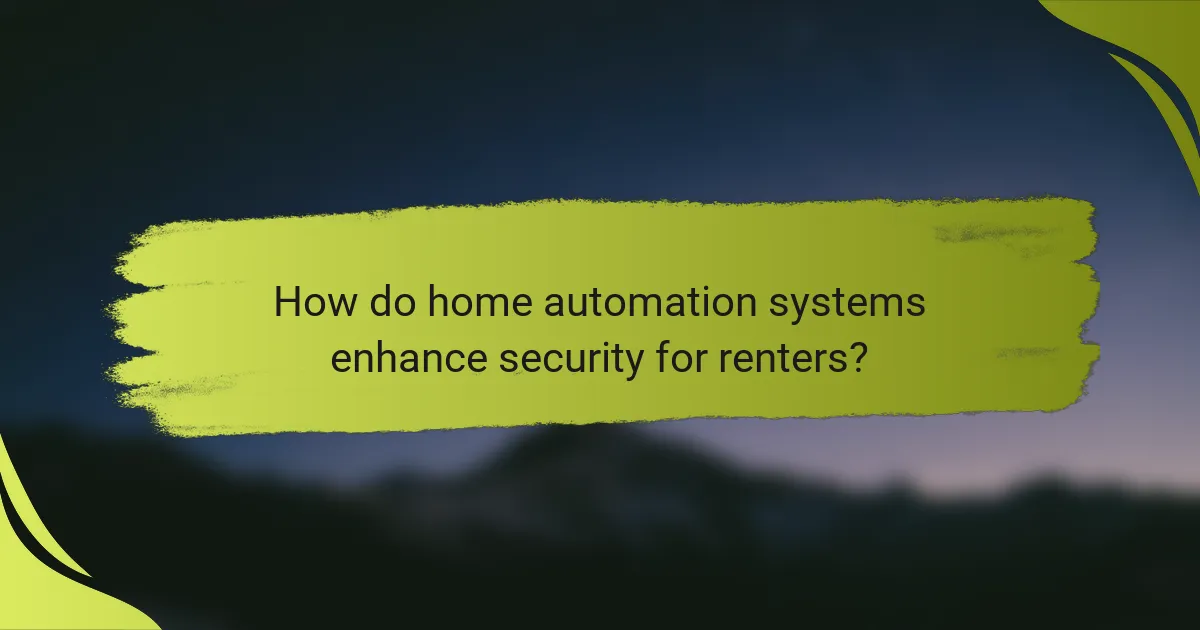
How do home automation systems enhance security for renters?
Home automation systems significantly enhance security for renters by providing advanced monitoring and control options. These systems allow for remote management of security features, making it easier to protect a rental property and respond to potential threats.
Smart door locks
Smart door locks offer renters a convenient way to secure their homes without the need for traditional keys. These locks can be controlled via smartphone apps, allowing users to lock or unlock doors remotely and grant temporary access to guests or service providers.
When choosing a smart lock, consider features such as keyless entry, integration with other smart home devices, and battery life. Look for models that provide alerts for unauthorized access attempts to enhance security further.
Security cameras
Security cameras are essential for monitoring the exterior and interior of a rental property. Many modern systems allow for live streaming and recording, which can be accessed remotely through mobile devices.
For renters, it’s important to select cameras that are easy to install and do not require permanent modifications to the property. Look for options with motion detection and night vision to ensure comprehensive coverage at all times.
Motion sensors
Motion sensors detect movement and can trigger alarms or notifications, providing an added layer of security for renters. These devices can be placed near entry points or in common areas to alert homeowners of any unusual activity.
When implementing motion sensors, consider the sensitivity settings to avoid false alarms from pets or passing vehicles. Additionally, integrating these sensors with a home automation system can enhance their effectiveness by allowing for immediate alerts and automated responses, such as turning on lights or cameras when motion is detected.
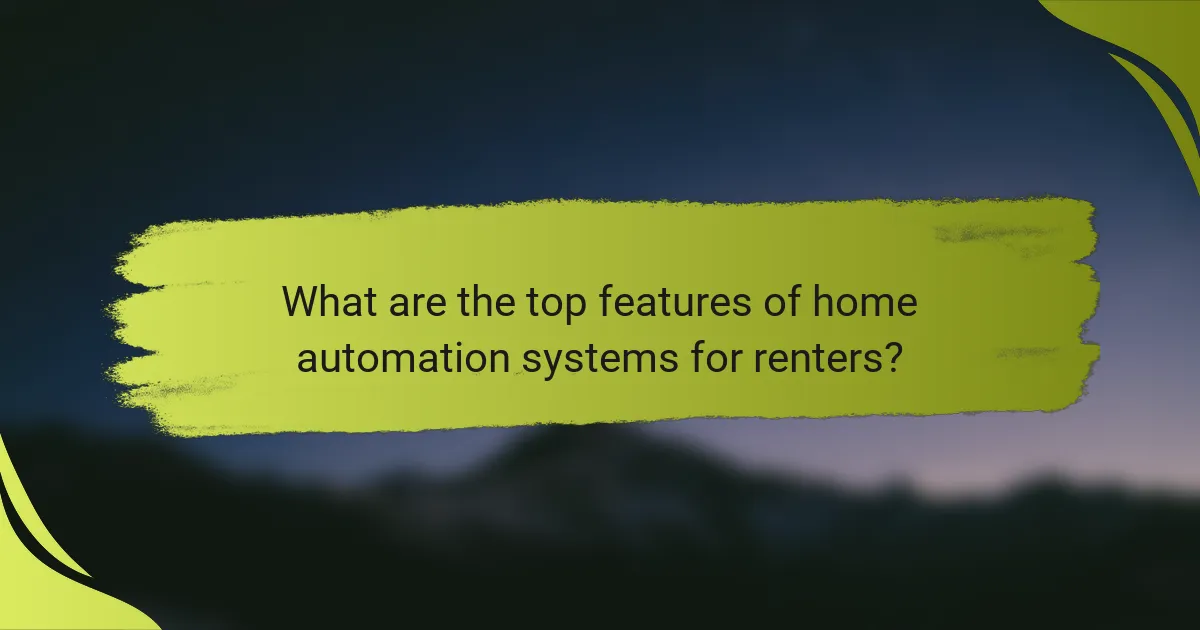
What are the top features of home automation systems for renters?
The best features of home automation systems for renters focus on convenience, energy efficiency, and ease of use. Renters often seek solutions that enhance their living experience without requiring permanent modifications to their space.
Remote control access
Remote control access allows renters to manage their home automation systems from anywhere using a smartphone or tablet. This feature is particularly useful for adjusting settings when away from home, such as turning lights on or off or managing the thermostat.
Many systems offer user-friendly apps that provide real-time notifications and control options. When selecting a system, ensure it is compatible with your devices and supports multiple users, which is beneficial for shared living situations.
Voice command functionality
Voice command functionality enables renters to control their home automation systems using voice-activated devices like Amazon Alexa or Google Assistant. This hands-free option adds convenience, especially when multitasking or when hands are occupied.
To maximize this feature, choose devices that integrate seamlessly with your existing smart home ecosystem. Check for compatibility with various voice assistants to ensure you can use your preferred system without limitations.
Energy monitoring
Energy monitoring features help renters track their energy consumption, providing insights into usage patterns and potential savings. These systems can identify high-energy appliances and suggest ways to reduce costs, which is especially valuable in regions with variable energy prices.
Look for systems that offer detailed reports and alerts for unusual energy spikes. This information can empower renters to make informed decisions about their energy use, ultimately leading to lower utility bills.
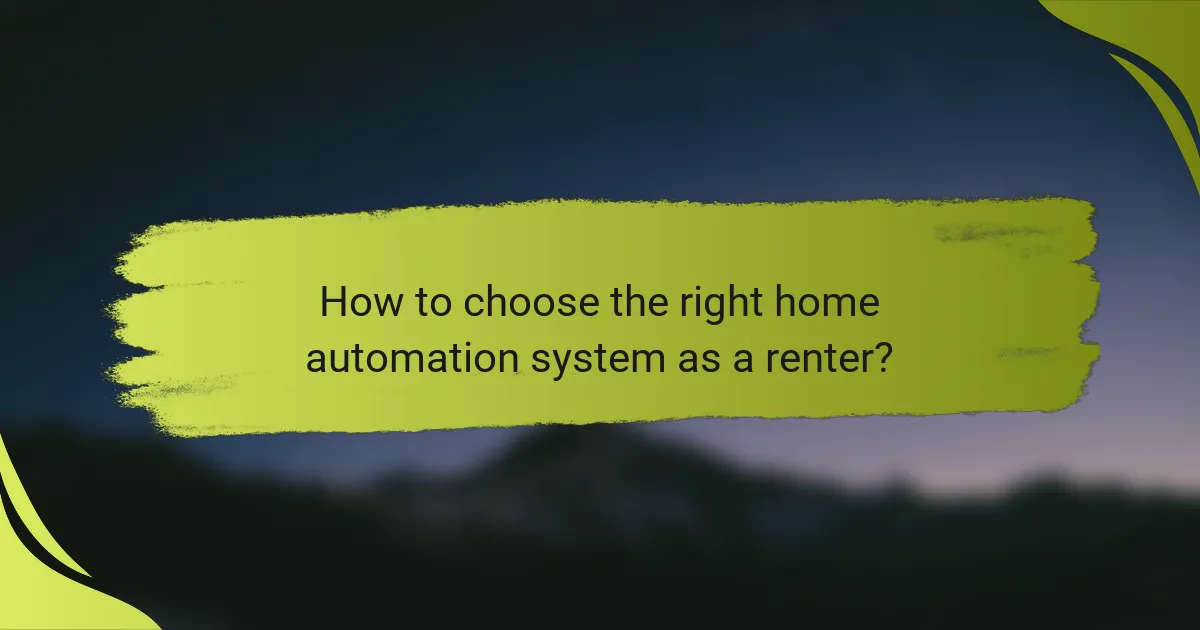
How to choose the right home automation system as a renter?
Choosing the right home automation system as a renter involves considering compatibility with existing devices, ease of installation, and scalability options. Focus on systems that enhance convenience without requiring permanent modifications to your rental property.
Compatibility with existing devices
Ensure the home automation system you select is compatible with your current devices, such as smart speakers, lights, and thermostats. Look for systems that support popular protocols like Zigbee, Z-Wave, or Wi-Fi to maximize integration.
Check the manufacturer’s specifications and user reviews to confirm compatibility. Systems that work seamlessly with your existing devices will provide a smoother user experience and reduce the need for additional purchases.
Ease of installation
Opt for home automation systems that offer straightforward installation processes, ideally without the need for professional help. Many systems today are designed for DIY setups, allowing you to get started quickly.
Consider plug-and-play devices that require minimal configuration. Avoid systems that necessitate extensive wiring or permanent alterations to your rental, as these may violate lease agreements.
Scalability options
Choose a home automation system that allows for easy expansion as your needs change. Scalability is crucial for renters who may want to add devices over time without replacing the entire system.
Look for platforms that support a wide range of devices and features, enabling you to start small and expand later. This flexibility ensures that your investment remains relevant as your living situation evolves.

What are the cost considerations for renters?
Renters should carefully evaluate the cost considerations of home automation systems, which include initial setup costs, ongoing monthly fees, and potential savings on utility bills. Understanding these factors helps renters make informed decisions that fit their budgets and living situations.
Initial setup costs
The initial setup costs for home automation systems can vary widely, typically ranging from a few hundred to over a thousand dollars, depending on the complexity and number of devices. Basic systems may include smart lights, plugs, and a hub, while more advanced setups could feature security cameras and smart thermostats.
Renters should consider whether they want to purchase devices outright or opt for rental options. Some companies offer packages that include installation, which can be beneficial for those unfamiliar with technology.
Monthly subscription fees
Many home automation systems come with monthly subscription fees for services like cloud storage, remote access, or premium features. These fees can range from around $5 to $30 per month, depending on the services provided and the number of devices connected.
It’s essential for renters to assess whether these recurring costs fit within their budgets. Some systems offer free basic services, which may be sufficient for those who do not require extensive features.
Long-term savings on utilities
Investing in home automation can lead to long-term savings on utilities, particularly through smart thermostats and energy-efficient lighting. Renters may see reductions in their energy bills by optimizing heating, cooling, and lighting based on usage patterns.
For example, smart thermostats can save up to 10-15% on heating and cooling costs by adjusting temperatures when the home is unoccupied. Renters should calculate potential savings to determine if the initial investment is worthwhile over time.
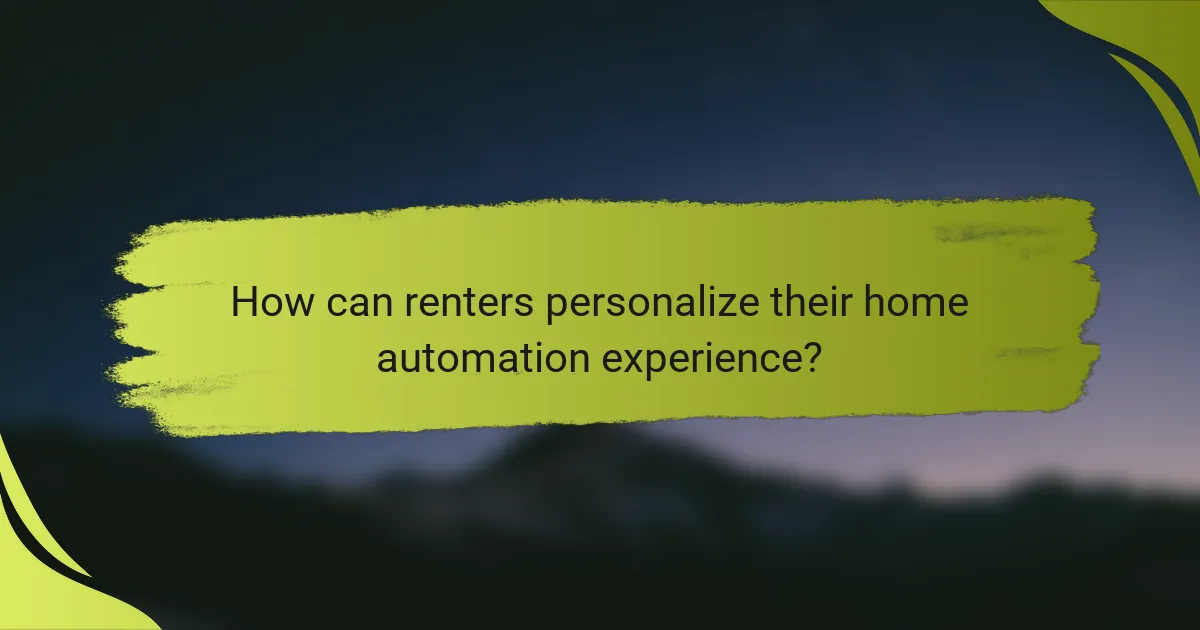
How can renters personalize their home automation experience?
Renters can personalize their home automation experience by selecting devices that fit their needs and integrating them into customizable systems. This allows for tailored routines and controls without the need for permanent installations.
Customizable routines
Customizable routines enable renters to automate daily tasks and enhance convenience. For example, you can set your smart lights to turn on at sunset or program your thermostat to adjust temperatures before you arrive home.
When creating routines, consider the devices you have and how they can work together. Many systems allow you to create triggers based on time, location, or device status, making it easy to adapt your environment to your lifestyle.
To maximize effectiveness, start with a few simple routines and expand as you become more comfortable. Avoid overcomplicating your setup; focus on the most beneficial automations that align with your daily habits.
